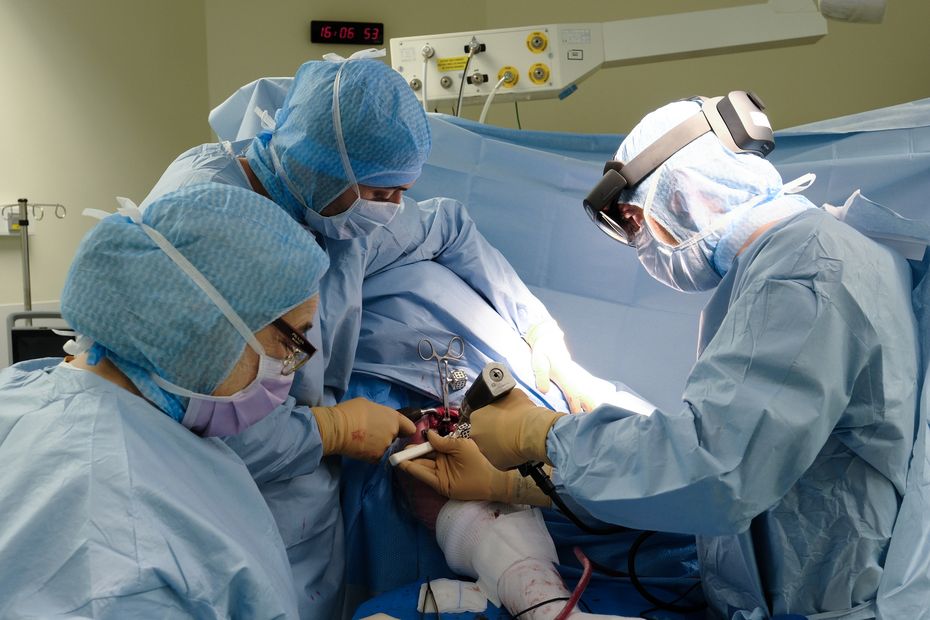Professor Julien Berhouet used augmented reality glasses to visualize his instruments, the prosthesis and the anatomy of the patient to be operated on in holograms. An innovation from Tours, it allows for unprecedented precision during surgery.
Virtual reality goggles on your nose. On the screen: a fake shoulder, a fake implant. To be placed, precisely, as precisely as possible. No, this is not the latest surgery simulator, but the real thing. Maybe the surgery of tomorrow.
Thanks to an innovation: a mixed reality headset called Stryker Mixed Reality Guidance. A tool that allows the surgeon to have precision, Professor Julien Berhouet has already used it on four patients in two weeks, to perform shoulder operations at the University Hospital of Tours. And at the moment “it's going well“
Orthopedic surgeon, augmented reality has already been in the spotlight His thesisDeveloped at Polytech Tours, it was supported in 2016. Production studies were then launched with Breton, which was bought by the American group Stryker. Since then, trials have been conducted across the Atlantic, by four surgeons in the United States and three in France.
In 2020, the glasses already made a splash, being used for the first time in operations in Tours. On the date, “What was displayed was the scanner, the information from the medical file, and a lot of information that I could navigate through without having to touch the paper, thus sanitizing myself.“Professor Barhouit says,”
Now, the helmet allows you to go even further. Before the operation, scans are taken of the patient's shoulder and one of the prosthetic limbs. The software then converts them into 3D models, which the surgeon can view as 3D images through his glasses.
A great advantage for accuracy:
The human eye can be off by about 10 degrees. A misaligned implant can break, is not ideal for longevity, and is not ideal for the patient.
Professor Julien Berhouet, Orthopaedic Surgeon and Traumatologist at Tours University Hospital
For example, the implant on the shoulder blade can be only two centimeters in size. Change a few millimeters and the whole thing will have to be rebuilt. Using mixed reality glasses (which display virtual reality in a real frame, editor’s note), the surgeon claims that the margin of error has been reduced to one millimeter and one degree.
Especially since shoulder prostheses are particularly delicate when put into place.”It is an area covered by muscles, like the hip, so we do not have any bony landmarks, unlike the knee for example.“
The mixed reality headset allows for a form of guidance, with the surgical equivalent of reverse radar. The stereoscopic projection greatly facilitates the correct alignment of the pin, which penetrates the shoulder blade and on which the position of the entire prosthesis depends.
The next six months will be devoted to a study on 60 patients, led by the University Hospital of Tours, and carried out in three other French hospitals. Two inaugural operations were carried out on the same day: one in Tours by Professor Berhouet, and the other at the Jean Mormoz Hospital in Lyon, by Doctor Lionel Niton.
Because although the device has been licensed for marketing, tests have so far only been performed on cadavers.”In real conditions, it is completely different: there is bleeding, subtle movements especially due to breathing…“Many factors, after publication,First scientific article These tests on cadavers require further in-depth studies.
Professor Barhouit now has two wishes. Indeed, his tool “What interests my fellow shoulder surgeons, and why it doesn't interest hip and spine surgeons?He also hopes to complete the development of glasses, especially for the second half of the artificial shoulder, on the humerus side. Tests are already underway on cadavers.

“Certified gamer. Problem solver. Internet enthusiast. Twitter scholar. Infuriatingly humble alcohol geek. Tv guru.”





